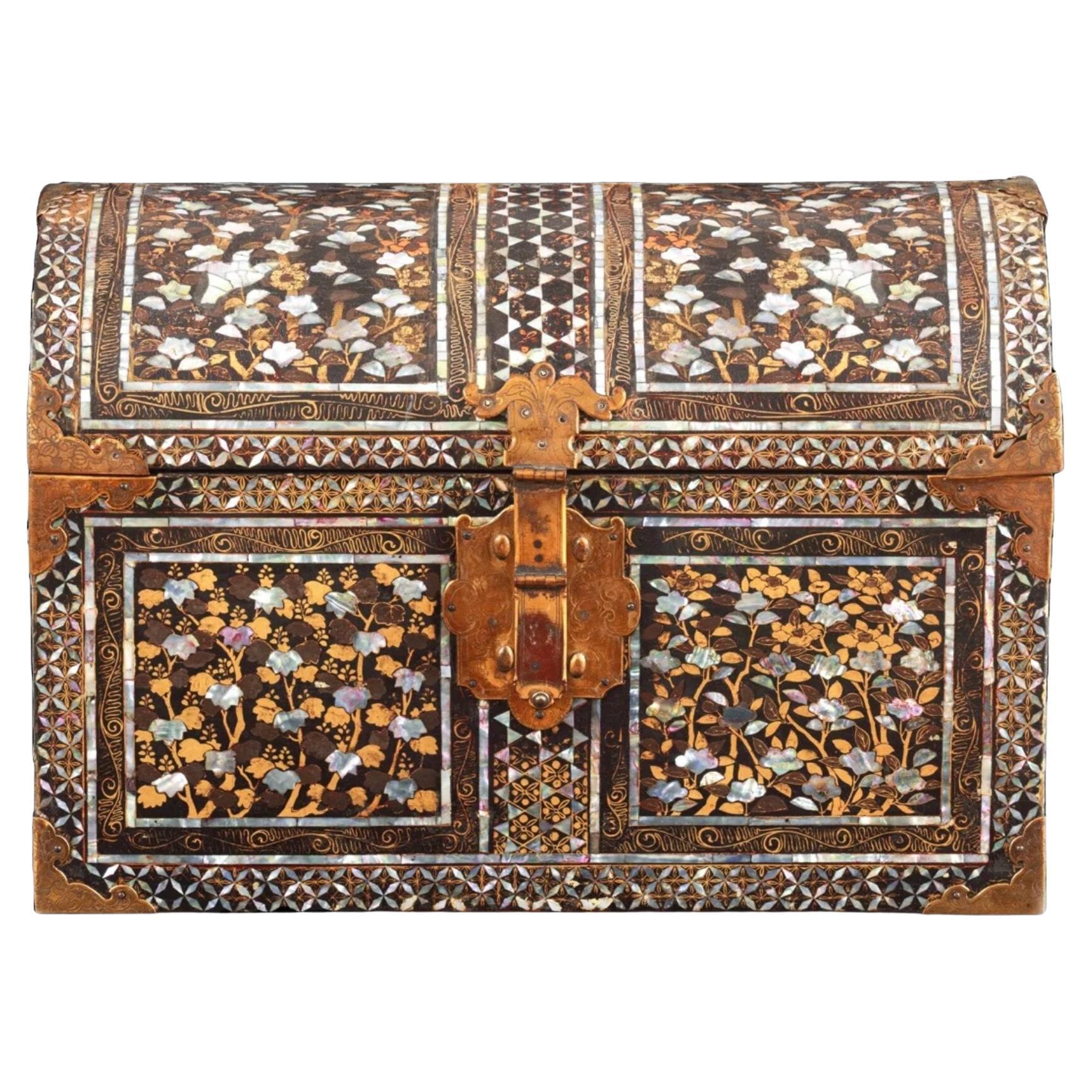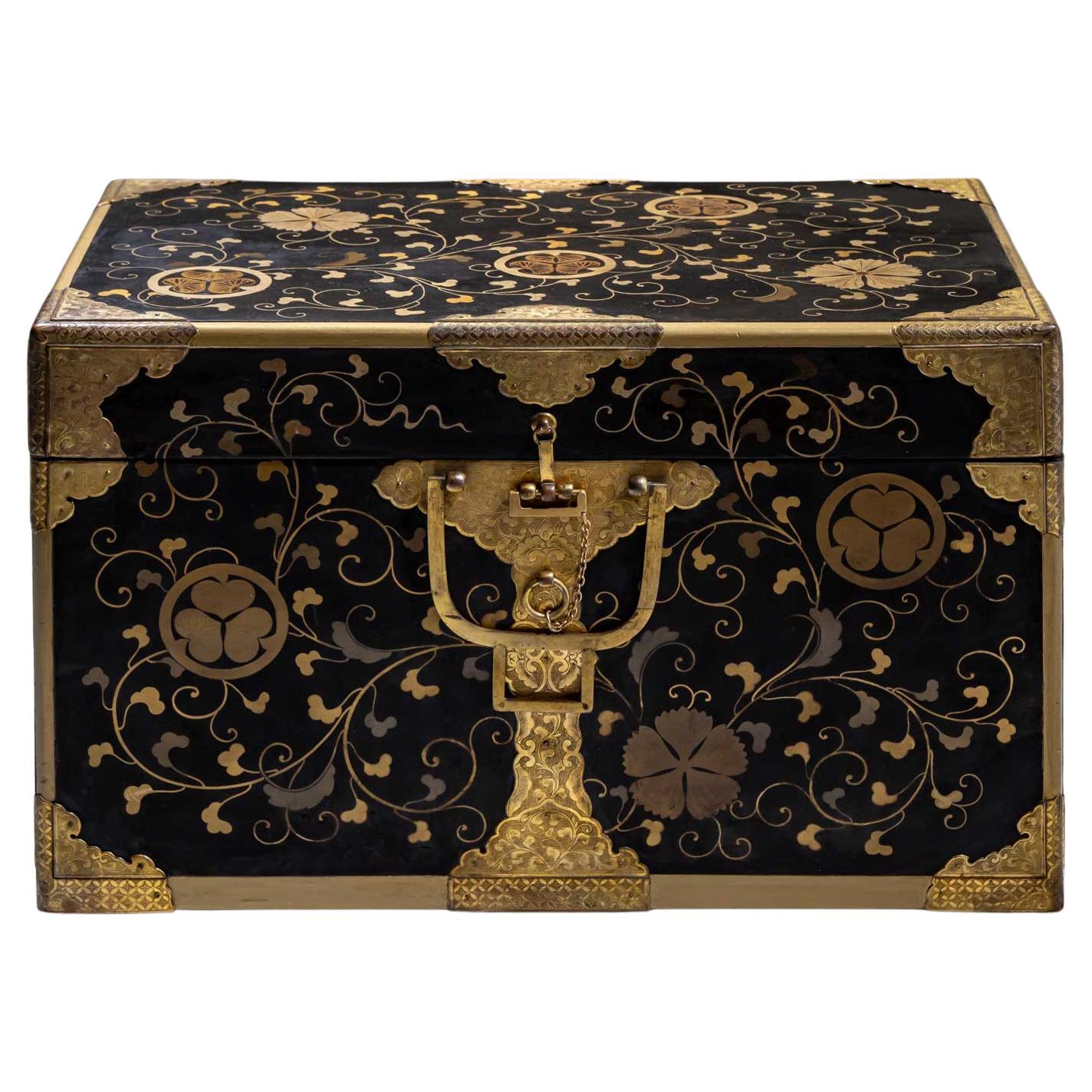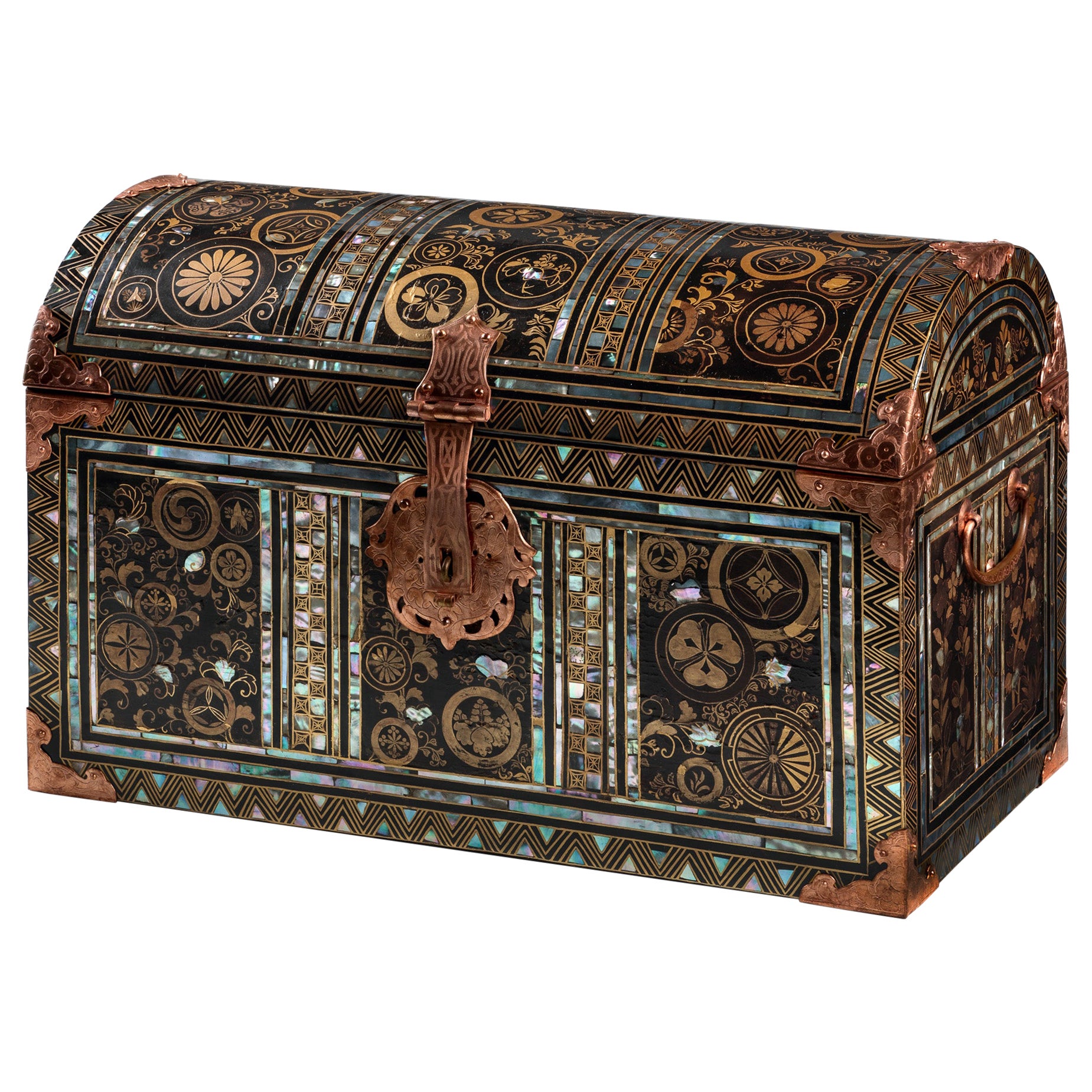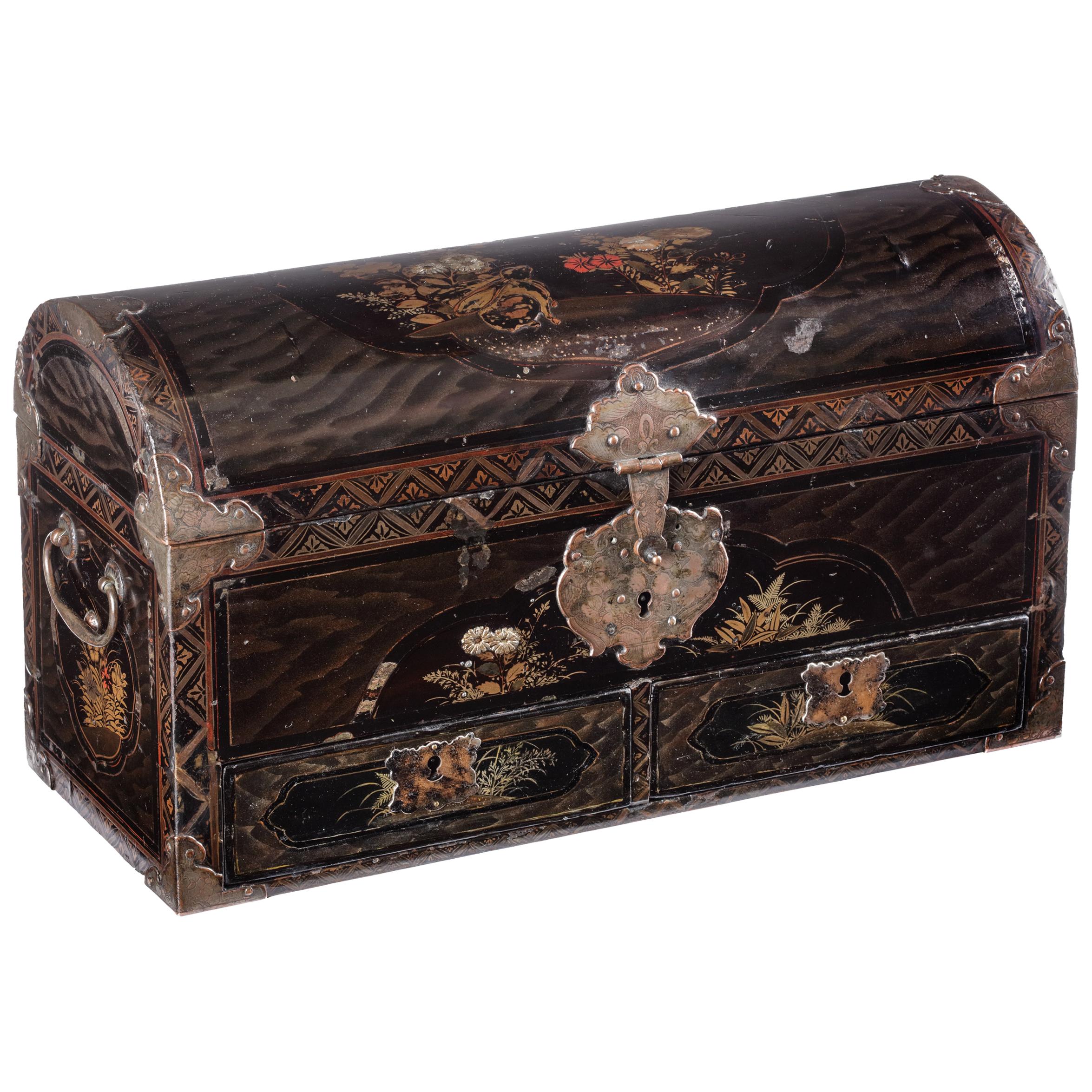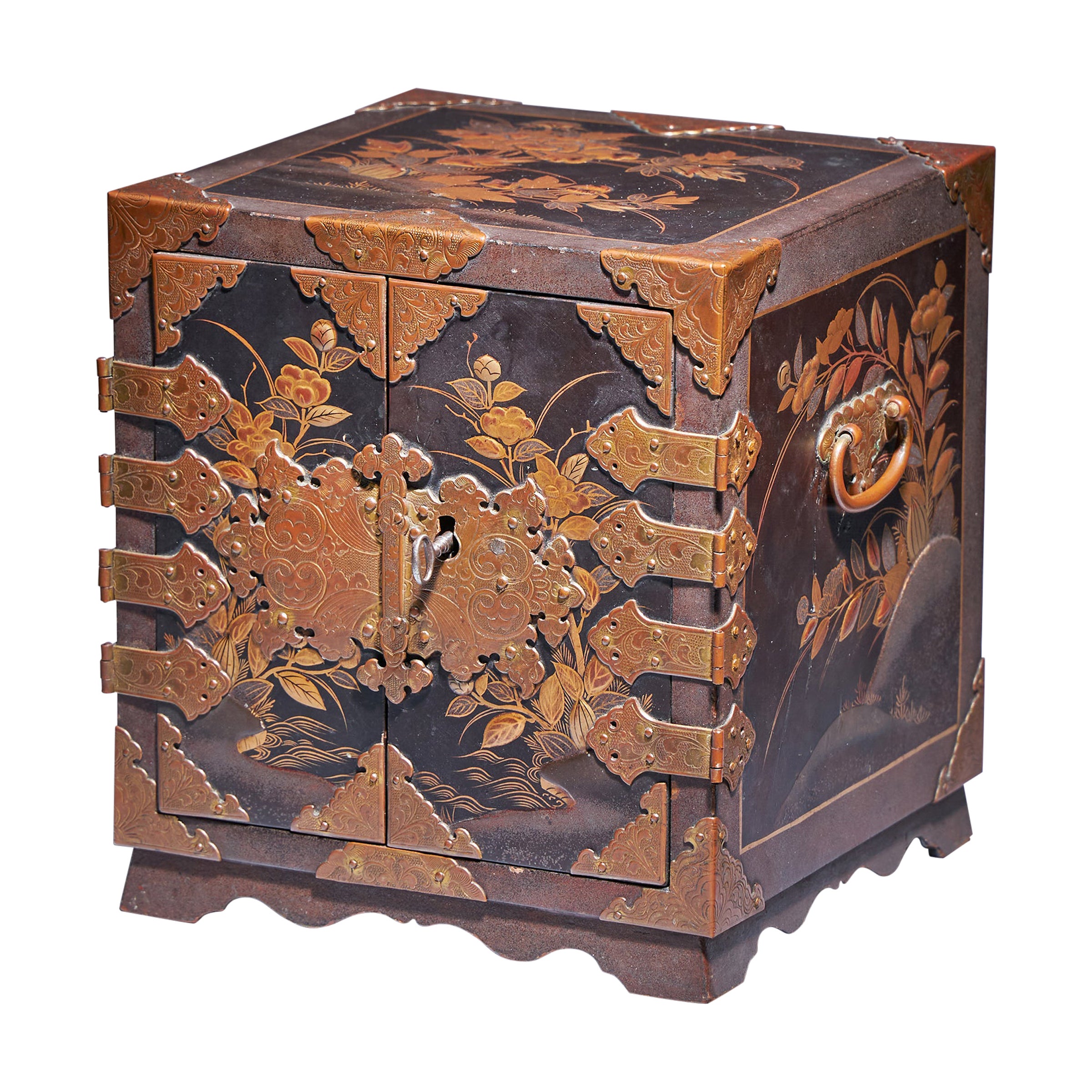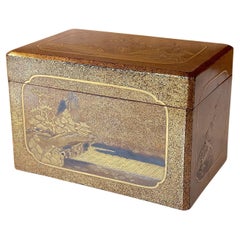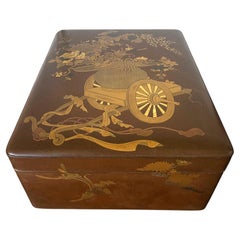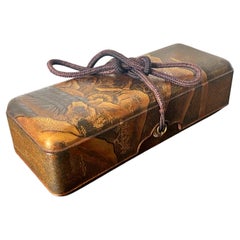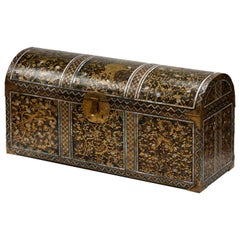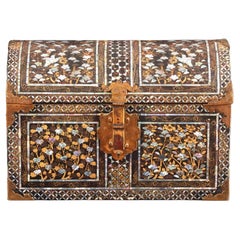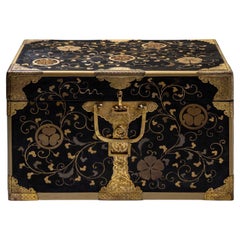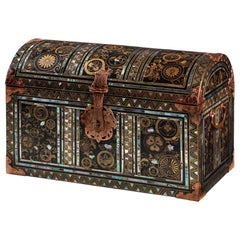Items Similar to Japanese Namban Lacquer and Inlay Coffer Momoyama Period
Want more images or videos?
Request additional images or videos from the seller
1 of 21
Japanese Namban Lacquer and Inlay Coffer Momoyama Period
$20,000
£15,186.47
€17,366.87
CA$27,942.90
A$31,078.60
CHF 16,228.28
MX$378,193.56
NOK 207,259.92
SEK 194,373.24
DKK 129,615.58
Shipping
Retrieving quote...The 1stDibs Promise:
Authenticity Guarantee,
Money-Back Guarantee,
24-Hour Cancellation
About the Item
A rare Japanese Namban Lacquer domed coffer circa 1570-1610s of Azuchi-Momoyama to early Edo period. These types of lacquerware were made for export to European Market and their production only lasted between 1573-1615 due to the historical Japanese foreign policy when the export was closed off in the beginning of the Edo period.
This is a fantastic piece in superb condition, of typical domed shape and accessorized with copper hardware. The surface was demarcated with geometrical diamond border, an archetypal requirement for the western market. Within the border, it was opulently decorated in Maki-e and raden inlays with a more Japanese style design that includes various birds such as rooster, goose and peacock, among large flowering branches of peonies, prunus and vines with foliage. These decoration in gold and MOP was strikingly set against a black roiro ground. The original copper hardware on the corner and front forms an integral part of the design and blends beautifully with the lacquer design. The interior surface of the coffer was covered in nashiji maki-e. Some spotted restoration is visible. The blue lash appears to be a later replacement.
Similar Namban coffers can be found in the collection of museum with large Japanese holding such as Ashmolean Museum in Oxford University, Peabody Essex Museum in Salem, MA.
- Dimensions:Height: 14.75 in (37.47 cm)Width: 26.8 in (68.08 cm)Depth: 12.7 in (32.26 cm)
- Style:Japonisme (Of the Period)
- Materials and Techniques:
- Place of Origin:
- Period:
- Date of Manufacture:1573-1615
- Condition:Repaired: possible old restorations to stabilize some cracks on the lacquer surface. Wear consistent with age and use. Minor losses. A surface crackle on the dome toward the back, minor losses and shrinkage on a few MOP inlay, possible older restorations, more visible in three Nashiji interior spots. Beautiful and even patina in general.
- Seller Location:Atlanta, GA
- Reference Number:1stDibs: LU945017039481
About the Seller
4.9
Platinum Seller
Premium sellers with a 4.7+ rating and 24-hour response times
Established in 2006
1stDibs seller since 2010
564 sales on 1stDibs
Typical response time: <1 hour
- ShippingRetrieving quote...Shipping from: Atlanta, GA
- Return Policy
Authenticity Guarantee
In the unlikely event there’s an issue with an item’s authenticity, contact us within 1 year for a full refund. DetailsMoney-Back Guarantee
If your item is not as described, is damaged in transit, or does not arrive, contact us within 7 days for a full refund. Details24-Hour Cancellation
You have a 24-hour grace period in which to reconsider your purchase, with no questions asked.Vetted Professional Sellers
Our world-class sellers must adhere to strict standards for service and quality, maintaining the integrity of our listings.Price-Match Guarantee
If you find that a seller listed the same item for a lower price elsewhere, we’ll match it.Trusted Global Delivery
Our best-in-class carrier network provides specialized shipping options worldwide, including custom delivery.More From This Seller
View AllAntique Japanese Lacquer and Inlay Box from Ryukyu Island
Located in Atlanta, GA
A lacquer presentation box with mother-of-pearl inlays from Japanese Ryukyu Islands circa 17-18th century. The lidded box in rectangular form with rounded corner is a classic example...
Category
Antique 18th Century Japanese Japonisme Lacquer
Materials
Mother-of-Pearl, Lacquer
Exquisite Japanese Lacquer Maki-e Hand Box Kobako Edo Period
Located in Atlanta, GA
An early Japanese lacquer Maki-e decorated kobako (small storage box) circa 18th century (Edo period). Based on its form and size, this kobako was possibly used as a Chabako to store the accoutrements for chado (tea ceremony). The lidded box is of rectangular form with bevel design on all edge that softens the appearance. The entire surface was densely covered with a background of nashiji. Elaborate Maki-e techniques were used on each side to showcase a distinct landscape or floral design within a cartouche panel. On the surface of the lid, a mountainous landscape rises from the edge of the water. The poetic composition is akin to a traditional ink scroll...
Category
Antique 18th Century Japanese Edo Lacquer
Materials
Lacquer
Japanese Lacquer Ryoshibako Document Box Meiji Period
Located in Atlanta, GA
A large Japanese lacquer box with elaborate Maki-e design from Meiji period, (mid-late 19th century). The generous size of the box was reser...
Category
Antique 19th Century Japanese Japonisme Lacquer
Materials
Wood, Lacquer
Japanese Lacquered Maki-e Fubako Edo Period
Located in Atlanta, GA
A Japanese lacquered wood fubako (a box used to store document or small scroll painting), circa second half of 19th century late Edo period. The rectangular box features an unusually deep lipped lid with slightly rounded corners, a conforming lower box that is almost entirely covered by the lid which has two bronze medallion rings with tasseled...
Category
Antique 19th Century Japanese Edo Lacquer
Materials
Wood, Lacquer
Fine Miniature Japanese Kodansu with Lacquer Inlays
Located in Atlanta, GA
A fine Japanese miniature kodansu constructed from Kaki wood (Persimmon) circa 19th century, late Meiji period. With its expressive exotic wood grains and exposed tenon construction,...
Category
Antique Late 19th Century Japanese Meiji Lacquer
Materials
Wood
Japanese Maki-e Lacquer Stack Box Jubako
Located in Atlanta, GA
An antique jubako (stack boxes) with five tiers in an elongated octagon shape circa 19th century (end of Edo or beginning of Meiji period). jubako was traditionally used to store and...
Category
Antique 19th Century Japanese Japonisme Lacquer
Materials
Wood, Lacquer
You May Also Like
Large Japanese Namban Lacquer Coffer Arqueta, 16th Century
Located in Amsterdam, NL
A large Japanese Namban lacquer arqueta coffer for the Portuguese market
Kyoto, Momoyama-period, late 16th century
In Hinoki cypress lacquered in ...
Category
Antique 16th Century Japanese Decorative Boxes
Materials
Mother-of-Pearl, Wood
Superb Late 16th Century Signed Colonial Japanese Namban Export Lacquer Coffer
Located in Amsterdam, NL
Superb late 16th century signed colonial Japanese Namban export lacquer coffer
Momoyama period, late 16th/early 17th century, inscribed 'Arisato' on the bottom
H. 30.5 x W. 43...
Category
Antique 16th Century Japanese Lacquer
Materials
Cedar, Lacquer
Japanese Lacquer Chest, Edo Period
Located in Greding, DE
Small rectangular Japanese chest with gold lacquer decoration in the form of leaf tendrils. The chest is decorated with cut-out and ornamentally engraved fittings on the corners and ...
Category
Antique 18th Century Japanese Edo Decorative Boxes
Materials
Brass
A rare Japanese Namban export lacquer coffer with Mon emblems
Located in Amsterdam, NL
Late Momoyama period, late 16th century
The coffer is decorated in black lacquer, urushi, on cedar wood, decorated with gold dust and silver, maki-e, and nashiji, mother-of-pearl, r...
Category
Antique 16th Century Japanese Lacquer
Materials
Silver, Copper
Fine Japanese Namban Lacquer Jewelry Casket, 17th Century
Located in Amsterdam, NL
Japanese Namban lacquer transition-style coffer with two drawers
Kyoto/Nagasaki, circa 1650
The cartouches with gilt and red decorations of leaves...
Category
Antique 17th Century Japanese Edo Lacquer
Materials
Cypress
Important Early Edo Period 17th Century Miniature Japanese Lacquer Cabinet
Located in Oxfordshire, United Kingdom
A Rare and Important 17th Century Miniature Japanese Lacquer Cabinet, 19 cm H, 17cm W, 16.5cm D.
The exquisitely decorated cabinet depicts fine floral raised scenes to each side. l...
Category
Antique 17th Century Decorative Boxes
Materials
Lacquer
More Ways To Browse
Blue Lacquer Furniture
Black Gold Lacquer
Wood Inlay Art
Japanese Lacquered Art
Black Lacquer With Gold Art
Black Lacquer Inlay
Copper Inlay
Japanese Black Lacquer Gold
Japanese Inlay
Japan Edo Lacquer
Japanese Hardware
16th Century Japanese
Japanese Wood Inlay
Japanese Antique Wood Birds
Large Coffer
Asian Black And Gold Decoration
Japanese Peacock
Maki E

